Notre Dame finally broke through in Palo Alto, gaining an edge with an explosive offense and a defensive crackdown after the first quarter. The Irish lost the efficiency battle but were more consistent stringing successful plays together and on passing downs, allowing the visitors to create far more scoring opportunities.
No garbage time was removed in the game. Starters were kept in for the entirety of the game and the only candidates for removal were the final drives by the Irish (three straight Jahmir Smith runs) and Cardinal (a few successful plays before time expired down 21).
Something not clear? Check out this handy advanced stats glossary.
Explosiveness
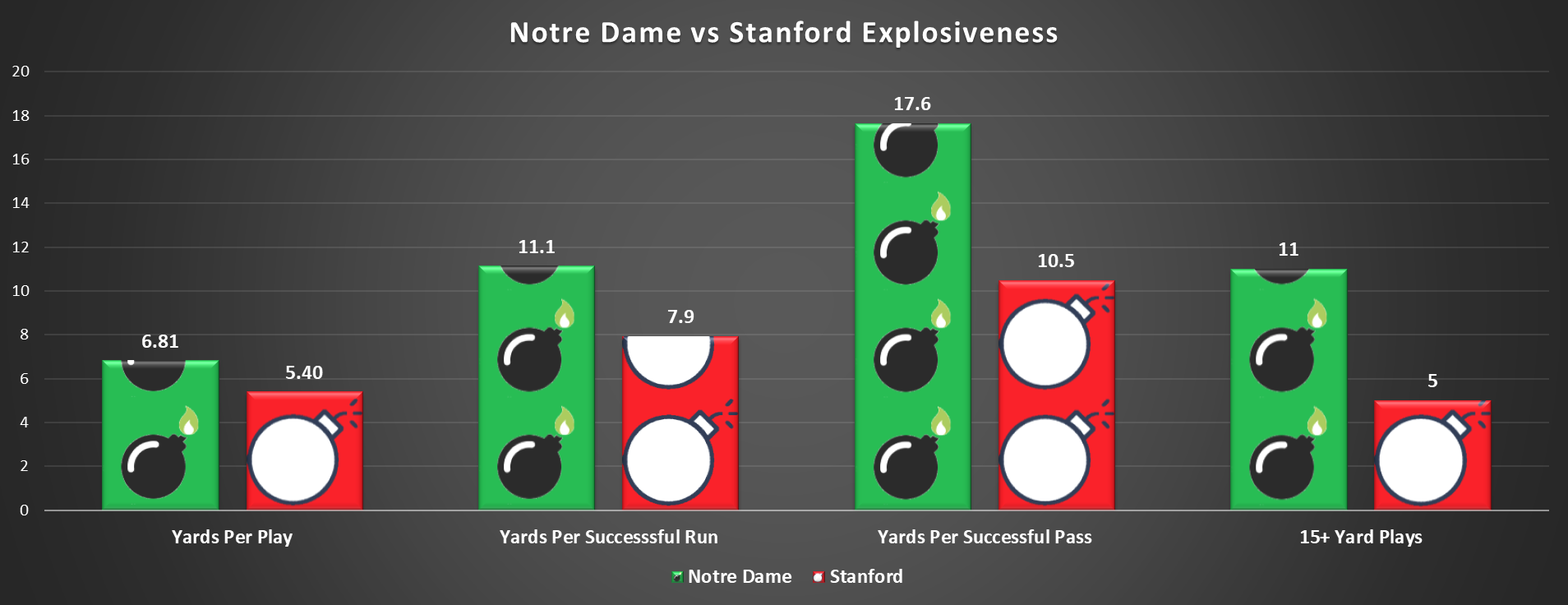
You’ll see below that Stanford had a decent edge in overall efficiency compared to Notre Dame. But the Irish were far more explosive, leading to a healthy +1.41 yards per play advantage that combined with turnovers blew this game open in the second half. Ian Book continued a strong November that more closely mirrored his 2018 performance than the struggles of the first half of 2019. Book averaged 8.45 yards per pass attempt and for a third straight game was extremely efficient. The passing game tallied seven plays of 15+ yards, with four different receivers chipping in.
After a disastrous first few drives, the Irish offense blanketed Davis Mills and the Stanford passing game, proving yet again that a one-dimensional offense is going to struggle against this Clark Lea defense. Opponents may start hot (add the Cardinal to Louisville, Virginia, and Virginia Tech all getting their hopes up) but that success is fleeting unless it’s a driving rain and let’s permanently bury that game as never having existed.
For all the deserved criticism Brian Kelly received for Brian Van Gorder, it’s slipped under the radar in comparison to how inspired Lea’s promotion was when Mike Elko sprung for the cash at Texas A&M. To put a considerable amount of faith in an unproven first-time play-caller that had only been in Kelly’s sphere for one season was risky, but Lea has exceeded even the most optimistic expectations in his first two seasons.
This was one of the least disruptive defensive performance for Notre Dame this year, but the low havoc rate doesn’t seem representative of the pressure the Irish put on the Stanford offense. There were several run stuffs for no gain which count toward that rate but not technically havoc, which only counts TFLs. And despite only coming away with two sacks the Irish were able to make Mills uncomfortable after the first few drives, forcing some scrambles and early throws that kept the Cardinal offense from attacking downfield.
Efficiency
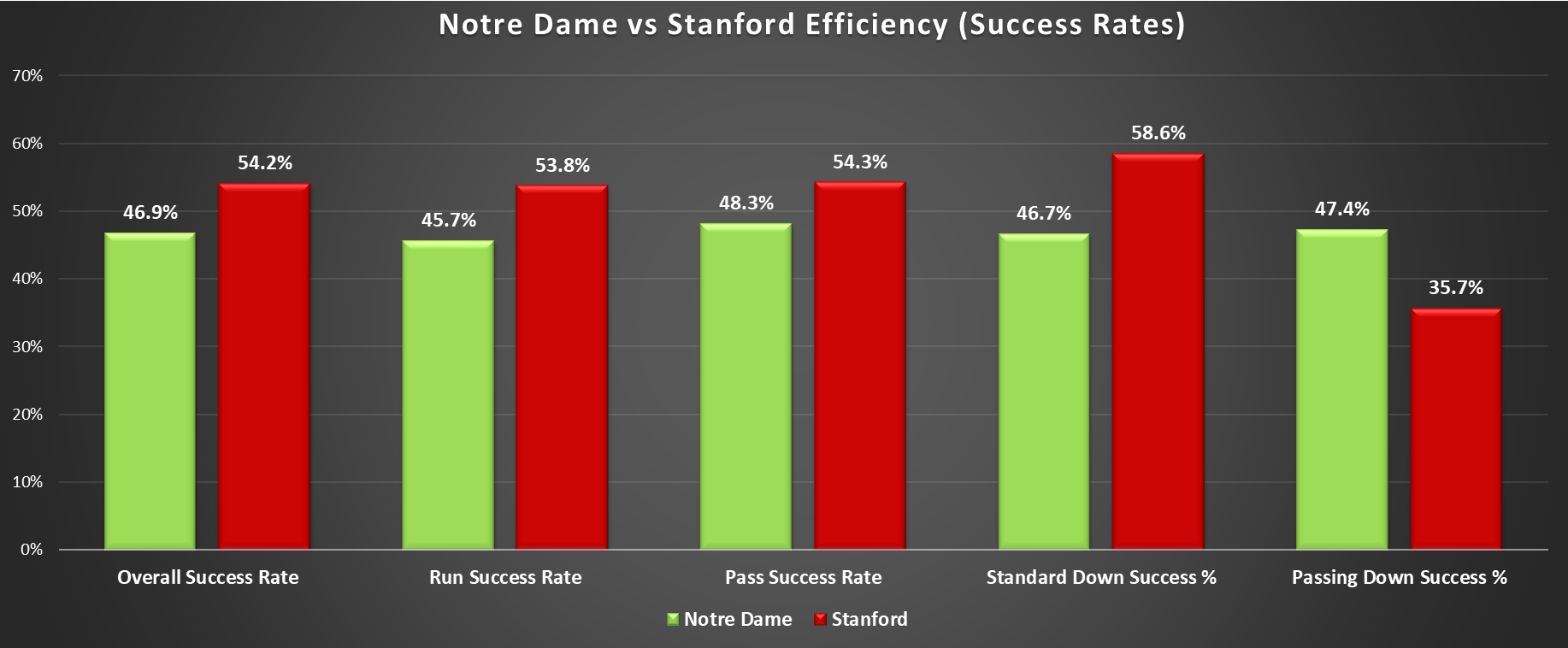
Both teams found above-average efficiency both through the air and on the ground, and I was surprised to see Stanford’s success rate this high. Looking back, Notre Dame’s sequencing and distribution of successes were far more even than the Cardinal’s, which let the Irish sustain more drives and create more scoring opportunities. David Shaw’s group was successful on 15 of their first 22 plays (68%) and 8 of their last 11 (73%) in the fourth quarter with the game out of reach.
This felt like a revitalized effort in the running game despite YMCA soccer field conditions and feeling the continued absence of Tommy Kraemer and Robert Hainsey. We’ll have the entire offseason to dissect the struggles of the run game, but the near-term success of the Irish rushing attack seems like it requires this balanced, multi-pronged approach. The running backs had 4.5 yards per carry, Braden Lenzy chipped in four carries for 12 yards a pop, and Book chipped in six carries for 30 yards.
The threat of Lenzy and Lawrence Keys should be a staple moving forward with the bulk of the ND run game returning next season (plus the welcome addition of a 5* burner in Chris Tyree). Realistically even with Tyree in the fold or Kyren Williams adding a more dynamic element, the ground game badly needs an injection of speed and misdirection to open things up further and create more explosive plays as well as increase efficiency. For the time being Lenzy might be Notre Dame’s most talented ball carrier and even as a decoy draws the attention of opposing defenses to open things up.
In addition to more consistent efficiency versus the Cardinal offense running super hot and cold, the Irish also were able to sustain drives with a very strong performance on passing downs. The Notre Dame offense fell behind the chains a decent amount thanks to unending false start plague of 2019 but rallied with strong second down playcalling and execution to avoid many 3rd and ultra-long situations. The Irish had 12 plays of 2nd down and 8+ yards to gain and averaged 9.8 yards on these plays with seven successes.
Finishing Drives, Field Position, & Turnovers
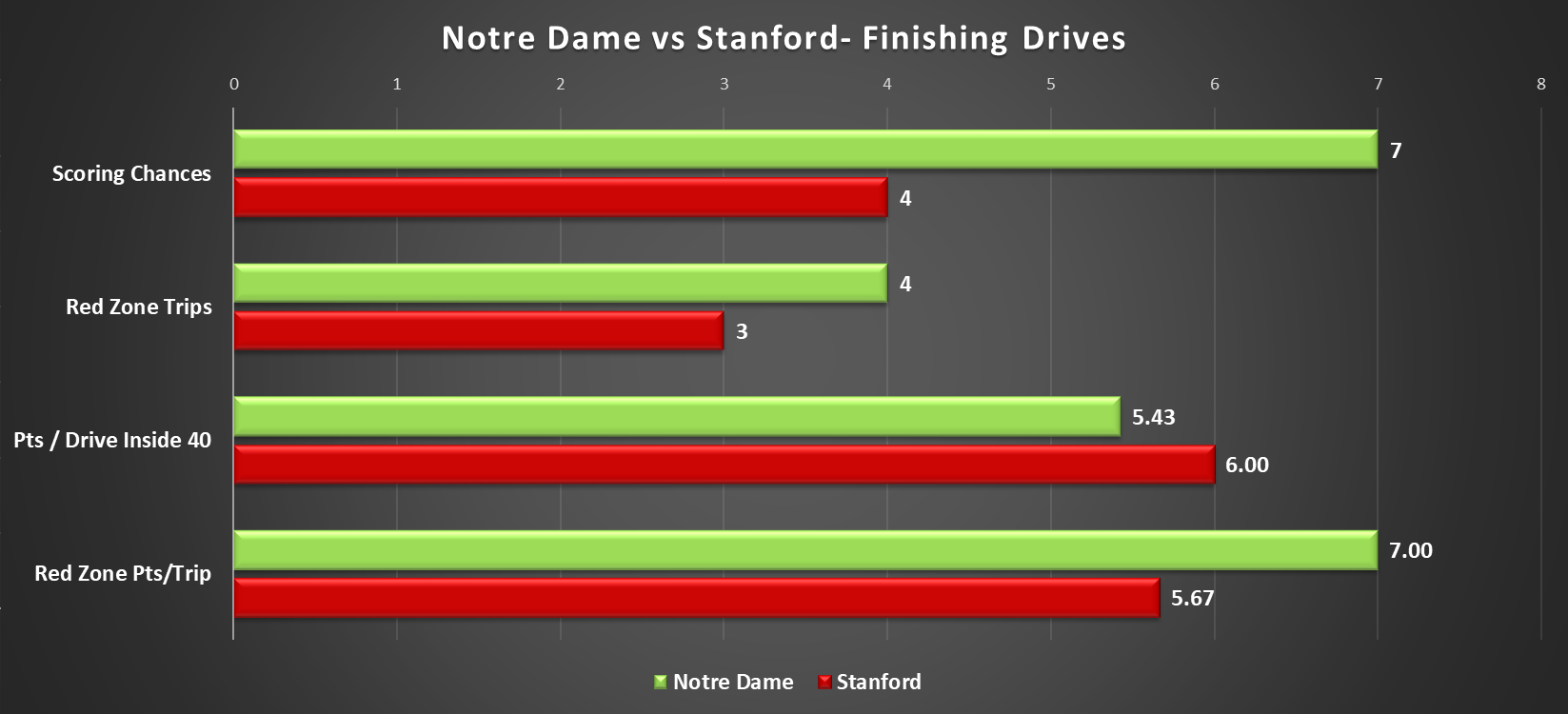
After leaving some points on the scoreboard settling for field goals against Boston College, the Irish offense returned to excellence converting scoring opportunities to touchdowns. After the rough start, it was impressive for the ND defense to hold Stanford to four scoring chances, one of which was meaningless in the 4th quarter with the game out of reach. I’ll break down some season-long statistics next week, but the Irish defense has sneakily not been great in points given up per scoring opportunity after excelling in that area in 2018. Things have worked out just fine though since opponents haven’t had many scoring chances.
Notre Dame gained a seven-yard edge in average starting field positions. Special teams were about even, so that margin is owed mostly to Isaiah Foskey’s incredible punt block.
| Fumbles | Lost | Expected Lost | PBUs | INTs | Expected Lost | Total Expected TOs | Actual TOs | TO “Luck” | |
| Notre Dame | 0 | 0 | 0 | 4 | 0 | 0.88 | 0.88 | 0 | +0.88 |
| Stanford | 2 | 2 | 1 | 4 | 0 | 0.88 | 1.88 | 2 | -0.12 |
After another clean game offensively the Irish finish the regular season with a turnover margin of +1.25 per game, tied for 3rd in FBS and only trailing Alabama in P5 competition. The advanced stats credit Notre Dame with a little luck in recovering both fumble opportunities and no interceptions off four Stanford pass breakups. But some of that luck SP+ observes was created – strip sacks and punt blocks are some of the likeliest turnovers to be recovered by opponents.
Parting Thoughts
- A reminder of how quickly things can change in college football – check out this power ranking of top college coaches from just 3.5 years (four seasons) ago. It feels like an insane list given what we know now
- #2 Urban Meyer: scandal / resigned
- #3 Jim Harbaugh: program now in existential crisis, hasn’t won his division
- #4 Mark Dantonio: 26-24 in last four seasons, including three with 6+ losses
- #5 Bob Stoops: retired
- #6: Gary Patterson: losing record in the Big 12 in three of four seasons since this list
- #7 Jimbo Fisher: bounced to Texas A&M after a disastrous end to his FSU tenure
- #8 David Shaw: things are not trending the right direction!
- #12 Bobby Petrino: hired Brian Van Gorder / fired unceremoniously from Louisville
- #13 Chris Petersen: just abruptly retired after a strong second stop in Washington
- #14 Tom Herman: making changes at both coordinator spots, went 7-5 in Year 3 at Texas after being preseason top 10
- #16 Mark Richt: resigned
- #17 Hugh Freeze: Yikes
- #18 Bret Bielema: another firing
- #23 Butch Jones: this is not a great list but incredible how much turnover there is
- #24 Pat Fitzgerald: fielded one of the worst offenses in B1G history, was an insane person in the media, went 1-8 in conference
- #25 Les Miles: things have improved in Baton Rouge since his exit
- One of my favorite annual exercises is the preseason “Counting Down the Irish” top 25 players list. We’re a long way from next August’s rankings, but wrapping up 2019 my brain drifted toward who the top players will be in those rankings and just how deep the list may be. A sample of my notes:
- Top 5 locks: Ian Book, Cole Kmet, Alohi Gilman if he comes back?
- Top 5 potential: Liam Eichenberg, Kyle Hamilton, Jeremiah Owusu-Koramoah, Braden Lenzy
- Proven high performers: Robert Hainsey, Tommy Kraemer, Daelin Hayes, MTA, Kurt Hinish, Drew White, Aaron Banks, come back please Shaun Crawford?
- High floor / high ceiling: Ade Ogundeji, Jayson Ademilola, Jacob Lacey, Tommy Tremble, Jarrett Patterson, Lawrence Keys, Jack Lamb
- Experienced dudes that do little important things: Tony Jones, Brock Wright, Jafar Armstrong, Javon McKinley if he returns
- All upside: Isaiah Foskey, Kevin Austin, blue-chip freshman skill guys, Paul Moala, redshirt freshman defenders
- Good specialists now seasoned: Jon Doerer, Jay Bramblett
- It’s definitely a best-case scenario, and there will be departures and transfers and injuries and suspensions, but that’s a fairly insane 30-deep list in terms of quality depth, upside, and experience. The future is bright.
- Next week I’ll begin breaking down the regular-season numbers for the offense and defense. If there’s any specific questions or requests about advanced stats or overall performance this year shout in the comments and I’ll do my best to dig up some insight.

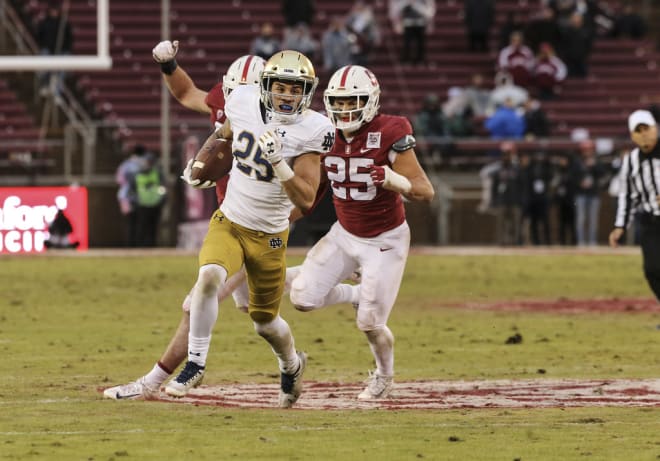
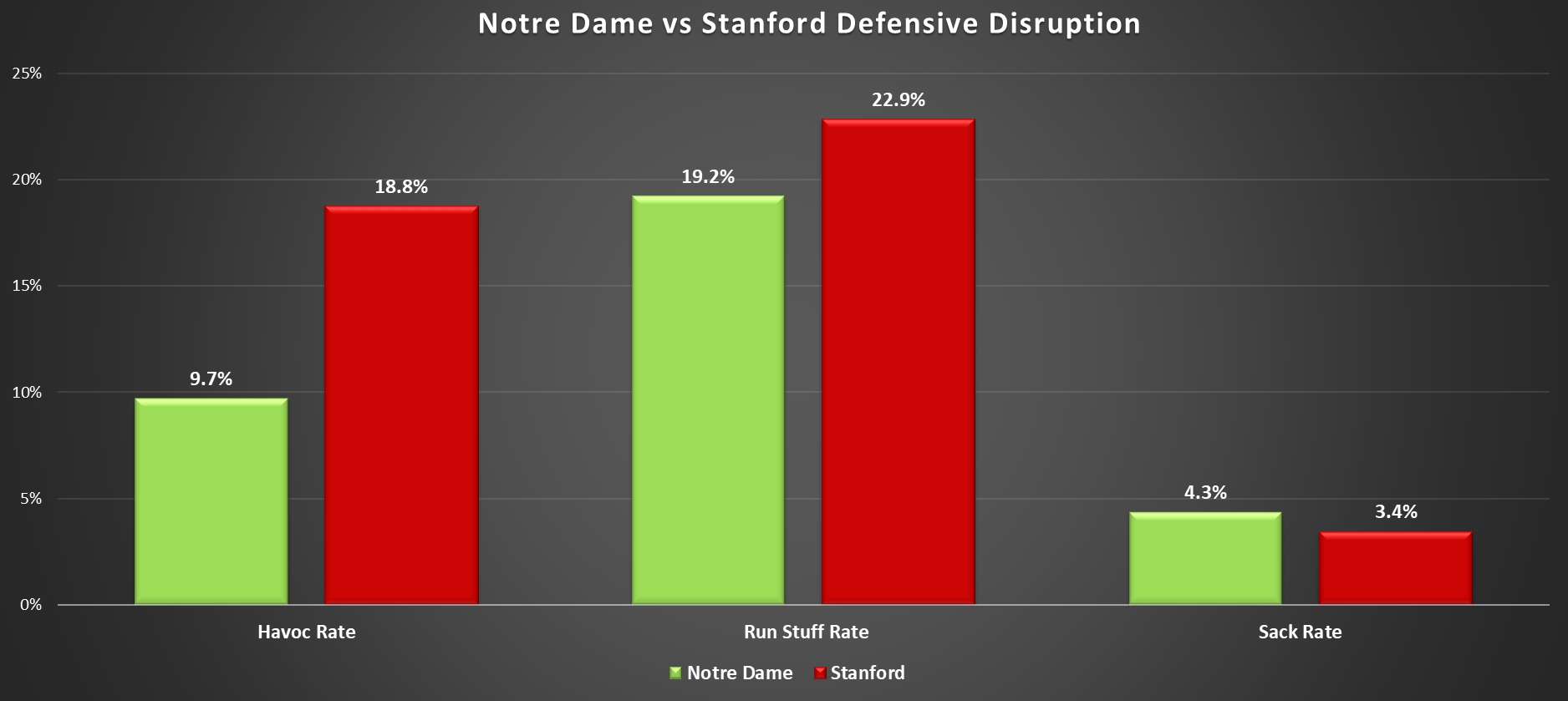


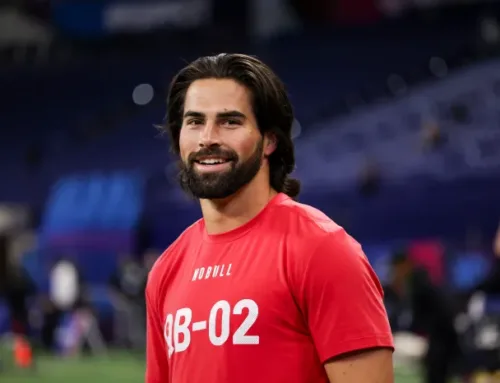
Punt blocks should be excluded from turnover luck entirely. It doesn’t even matter who recovers the football, the return/blocking team gets it.
Except when the team that blocks the punt tries to jump on the ball after it passes the line of scrimmage but flubs it and the kicking team recovers.
Who am I kidding? That would never happen, so I guess you’re right.
You guys are both right and that one is on me – I thought they were counting the punt block as a fumble/turnover but I forgot the muffed punt return (which would actually be more 50/50, although that again is a situation more often recovered by the defense I’d guess). Anyways, the turnover luck numbers are right, my account of it not so much!
My reply was really just a snarky reminder of what unfortunately happened to us. The one and only time when a punt block could be a bad thing and we somehow bumbled our way into it…
I also assumed that the advanced stats site’s turnover luck actually counted the punt block. Wasn’t meant to be a shot at MB. I pretty blindly trust you, and was attempting to throw shade at mysterious internet sites.